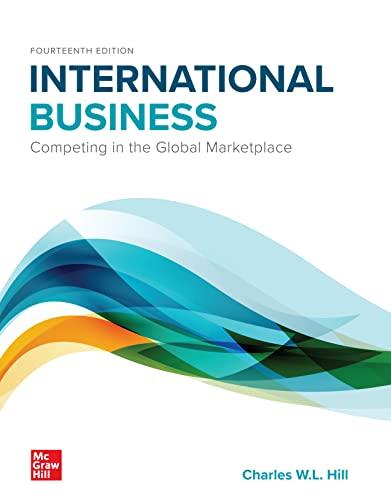A hundred years ago, the South American nation of Argentina was one of the worlds wealthiest countries.
Question:
A hundred years ago, the South American nation of Argentina was one of the world’s wealthiest countries. Its success was based on rich natural resources, a productive agricultural sector, an educated population, and an emerging industrial sector. Along with Australia and America, Argentina was one of the favored destinations for European immigrants. For much of the last 70 years, however, Argentina has stumbled from economic crisis to economic crisis. It now ranks around 60th in the world in terms of GDP per capita.
One problem is that successive governments have routinely spent more than they have made in taxes and other income—which has happened every year but one since 1950. To finance high public spending and persistent budget deficits, Argentina has often resorted to printing money. This has fueled inflation.
Indeed, Argentina has frequently recorded some of the highest inflation rates in the world. Persistently high inflation has hurt business investment as Argentines have looked for ways to move their money out of the country and into a stable currency that maintains its value, such as the U.S. dollar. Similarly, foreign businesses have limited their investments in the nation. Starved of capital, Argentinian enterprises have not been able to make productive investments, and economic growth has faltered.
The country’s history of high public spending dates back to the 1930s when Juan Peron, a charismatic Argentinian army officer, returned from a posting in Italy. Peron was an admirer of fascism in Germany and Italy. As National Labor Secretary and then president, he put his learnings into practice. As Labor Secretary, he created health, pension, and low-cost housing benefits, all very popular with the working class. As president, a position he held from 1946 to 1955, he brought unions under his control, nationalized utilities, the railways, tramways, and the merchant marine among other formally private enterprises. Wages rose, but production plummeted, inflation soared, and a revolt in 1955 forced him into exile. Despite this, the populist Peron left a legacy that still shapes the country’s politics and economic policies.
Argentina has been governed by Peronists several times since 1955, most recently from 2003 to 2015.
During the most recent period of Peronist rule, public spending surged to account for more than 45 percent of Argentina’s economy. The number of public employees increased by more than 60 percent. The government expanded state intervention in the economy, nationalizing the largest oil company in the country. Argentines became accustomed to paying some of the world’s lowest electricity bills as the state spent billions on energy subsidies.
Payroll and welfare costs surged as benefits were expanded. Tariff barriers were raised to protect the country’s inefficient business from foreign competition.
Exports of agricultural and manufactured goods were also taxed to divert production to domestic consumption—
a policy almost unheard of in modern economies. Export tariffs limited the opportunity for export-led growth and depressed real prices and returns to investment in the affected sectors. These nationalistic policies effectively isolated Argentina from the global economy, leaving it increasingly further behind in a self-imposed deep freeze.
In November 2015, Mauricio Macri, a centerright politician, won the presidential election against the incumbent Peronist Cristina Fernandez. Upon taking office, Macri embarked upon a reform program designed to liberalize the economy and promote greater economic growth. Among other actions, he removed or reduced some of the export taxes, cut some energy subsidies, and worked with the International Monetary Fund to try and shore up government finances. He also signed onto a trade deal between Mercosur, a four-country South American trade block that includes Argentina and Brazil, and the European Union. But he moved cautiously, did not cut the deficit fast enough, and was reluctant to impose further austerity on the country for fear of a backlash. He got a backlash anyway. His cautious government failed to rein in inflation, which exceeded 50 percent, and the economy contracted by 6.2 percent in 2018. By 2019, two-fifths of Argentina’s citizens could not afford a monthly basket of staple goods. In November of that year, Macri lost the presidential election to his Peronist rival, Alberto Fernandez.
Alberto Fernandez has advocated a return to classic Peronist policies, including subsidies and higher welfare benefits but has promised to be more pragmatic than the last Peronist government. He has floated the possibility that Argentina will default on some of its foreign debt, has blamed the country’s problems on austerity policies required by the IMF in exchange for loans, and has signaled that he will not accept the Mercosur trade deal negotiated by his predecessor in its current from. He has also pushed for higher taxes on agricultural exports, including corn, wheat, and soybeans. The goals of the export taxes include raising money for the government and diverting agricultural produce to the domestic market, where increased supply should lower food prices to Argentines. Whether any of this will help Argentina’s economy remains to be seen, but if history is any guide, the prospects are not encouraging. In general, countries that turn their backs on international trade and implement subsidies and welfare programs they cannot finance do not do well.
Case Discussion Questions 1. What are the root causes of Argentina’s relatively poor economic performance? Explain how these causes have impacted the country’s economic growth rate.
2. How would you explain the persisting appeal of Peronism in Argentina, even though the economic track record of Peronist governments has not been good?
3. What policies do you think the government of Alberto Fernandez should pursue? How might these policies help Argentina achieve higher economic growth rates?
Step by Step Answer:

International Business Competing In The Global Marketplace
ISBN: 9781260387544
14th Edition
Authors: Charles Hill





